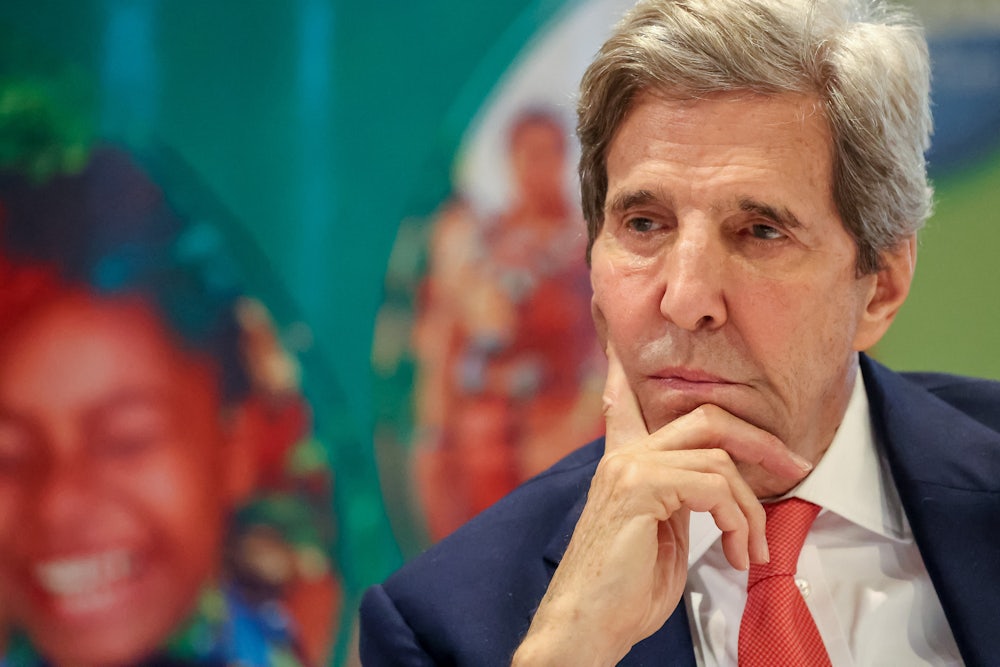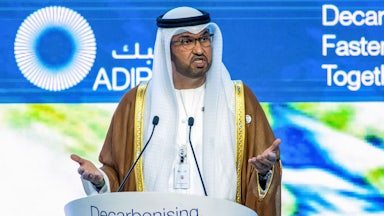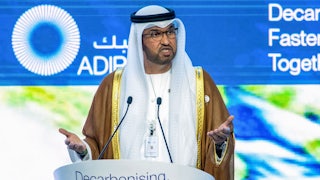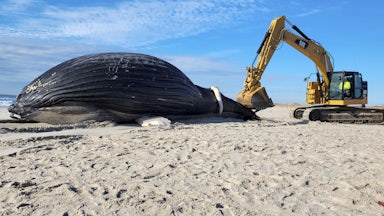On the very first day of the United Nations’ climate change conference last week, negotiators notched an uncharacteristically early win: Nations agreed to establish a dedicated fund for loss and damage—i.e., to help countries recover from the effects of climate change.
A loss and damage fund looked like an epic long shot until almost the last minute of last year’s climate talks in Egypt, when the United States abruptly relented, after years of pressure to stop blocking the fund. Shortly after that conference, known as COP27, a Transitional Committee composed of representatives from each region of the world got together to figure out what the fund should look like, with the goal of bringing a recommendation to this year’s talks. But the committee still hadn’t reached an agreement after their four scheduled meetings. They reconvened for an additional session a few weeks ago in Abu Dhabi, hoping to agree on something they could bring to Dubai. Not only did they manage to come up with a text to present for negotiation at COP28, but the text was approved quickly and with only minor revisions.
Those who have long advocated for a loss and damage fund are now celebrating a huge and (until recently) unexpected victory. But they’re also paying close attention to what happens next: Namely, will the “fund” have any funds to spend? And who’ll be calling the shots?
For a long time, U.S. negotiators blocked “loss and damage” discussions because the U.S. prefers to treat all climate aid as “mitigation and adaptation.” The language of “loss and damage,” by contrast, implies that rich nations might owe poorer nations compensation for the disasters cause by their historical emissions.
America’s eleventh-hour change of heart at last year’s climate conference (COP27) gave advocates hope. But according to those tracking negotiations, over the last month U.S. negotiators have pushed for changes that have thrown the prospective success of the loss and damage fund into question. Unlike previous versions, the final text agreed to last week sets up no process to “capitalize” (i.e., fund) the fund, instead only inviting “financial contributions with developed country Parties continuing to take the lead to provide financial resources for commencing the operationalization of the Fund.” So while richer countries are being asked to volunteer funds to get the fund up and running, there is no parallel invitation in the text for them to contribute toward actual loss and damage financing. The U.N. could theoretically be setting up an empty shell with little to spend. (The State Department did not respond to a request for comment on this article in time for publication.)
The $700 million participating nations have already committed to the fund will only pay for an estimated 0.2 percent of the irreversible economic and noneconomic losses developing countries are facing from global heating every year. And the $700 million figure may not be completely accurate, as some pledges—which do not come with any legal commitments—could refer to money going directly to the loss and damage fund but could also refer to broader “funding arrangements,” which can mean just about anything.
“That was an extremely disappointing meeting,” said Brandon Wu, who leads ActionAid USA’s climate justice work, referring to the last Transitional Committee meeting before the conference got started. “We feel like the developed countries got everything that they wanted and bullied developed countries into accepting their terms.”
Throughout those talks, the U.S. had been especially adamant that the fund at least initially be hosted by the World Bank, in which the U.S. is the largest shareholder. The draft text countries agreed to on Friday says the fund will be governed by its own board and executive director, though it will still be subject to World Bank H.R. policies and other administrative procedures. The World Bank also charges a baseline 17 percent administrative fee to host these sorts of independent funds. Within eight months, the World Bank will also have to at least make progress toward satisfying several conditions before it can host the fund. Among the most important is allowing countries direct access to funds, which according to current World Bank rules need to be dispersed via intermediaries.
As critics of the plan to host the fund at the World Bank pointed out, the bank is not known for offering the kinds of grants that loss and damage requires. The kinds of “bankable,” return-generating projects able to court private investors in the ways World Bank initiatives tend to prefer are relatively scarce when it comes to loss and damage. Countries already struggling under enormous debt burdens, moreover, could find themselves deeper in the hole if forced to ask for more grants to build back from climate-fueled storms, floods, and fires.
Liane Schalatek, who leads the Heinrich Boell Foundation’s work on climate finance, worries that—even though the fund is officially independent—its interim secretariat could be overwhelmingly staffed by people coming out of multilateral development banks, or MDBs, who share those institutions’ preference for loan-based aid and partnerships with the private sector. “That cannot be the operating model for a loss and damage fund,” she told me. “It’s important for it not to have a banking approach.” Instead, a loss and damage fun, she told me, needs to offer “largely grant-based support.”
Oxfam has found that upward of 90 percent of the climate financing offered by multilateral development banks between 2019 and 2020 came in the form of loans. “If you’re doing everything like an MDB, then you might as well have set it up under an MDB,” Schalatek added, reiterating that the fund will be officially under the auspices of the U.N. Framework Convention on Climate Change and the Paris Agreement.
The timeline for getting the fund officially up and running is a short one: Regions are meant to choose representatives to send to the governing board for a first meeting by the end of January. And while there are no more formal discussions scheduled on the loss and damage fund at COP28, negotiators are debating how the Global Stocktake—the primary document these talks are supposed to produce, which “takes stock” of where the world stands on emissions reduction, funding, and more—will address loss and damage. Conversations this year will also set the stage for next year’s announcement of a successor to the $100 billion climate financing commitment made in 2010 and achieved in 2022. Developing countries are eager to see loss and damage included in whatever pledge comes next; many developed countries would rather leave it out.
Because it took years of intense pressure for the UNFCCC to establish a loss and damage fund, even those criticizing how rich nations want the fund to work see its creation as a major victory. Like just about all climate policy, though, it’s hard to know how these promises will play out. Making sure a victory still feels like a victory in 10 years’ time entails a lot of work.








